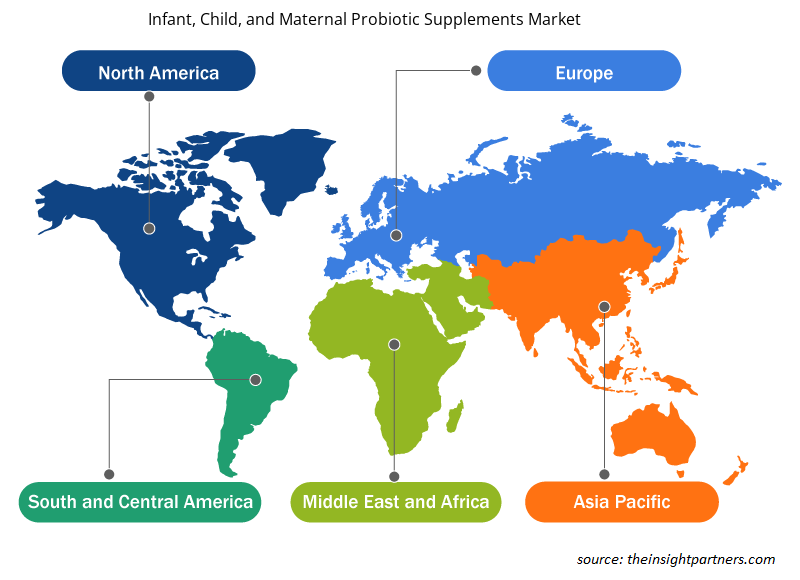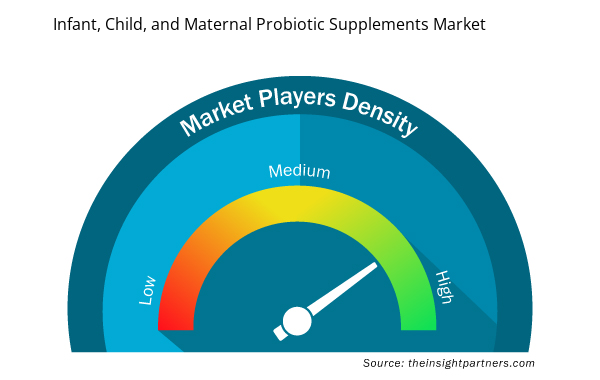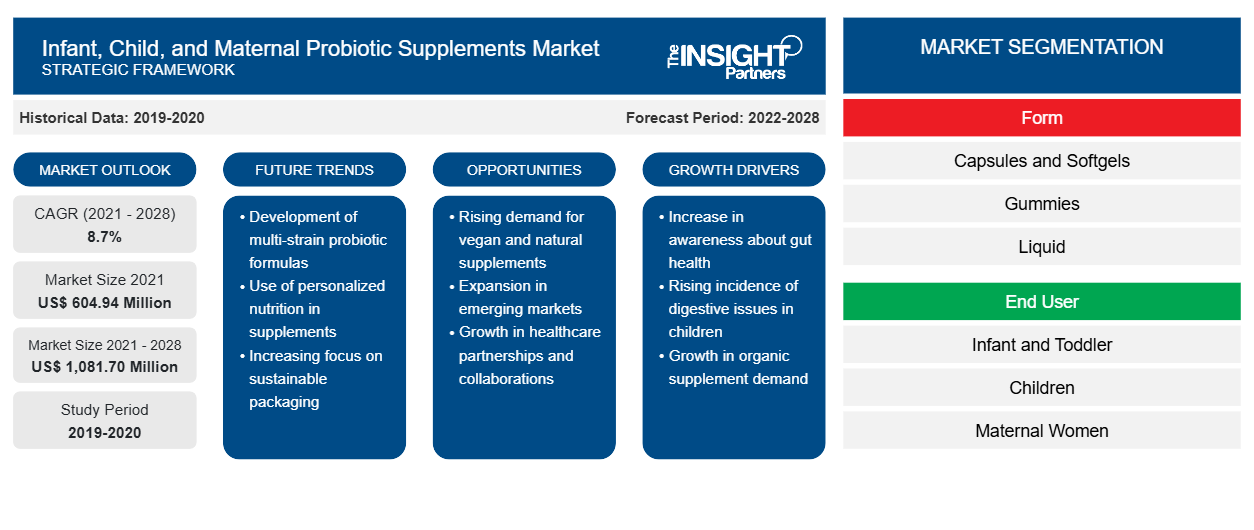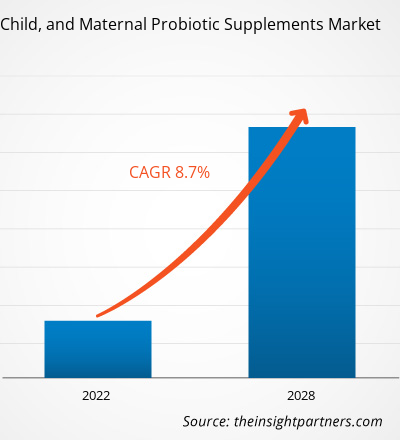婴儿、儿童和孕产妇益生菌补充剂市场规模预计将从 2021 年的 6.0494 亿美元增至 2028 年的 10.817 亿美元。预计 2022 年至 2028 年的复合年增长率为 8.7%。
益生菌是活细菌和/或酵母,有益于人体肠道健康。益生菌补充剂的各种好处包括增强肠道微生物群、恢复微生物群平衡和支持免疫系统。这些好处使其在目标受众中的使用量激增,其中包括婴儿、儿童和孕妇。父母越来越关注孩子的营养和健康,推动了市场的发展。此外,孕妇越来越多地采用益生菌补充剂也大大促进了市场的发展。全球范围内对这一类别的持续研发将在未来几年提升市场增长
2020 年,北美占据全球婴儿、儿童和孕产妇益生菌补充剂市场的最大份额,而亚太地区预计在预测期内将实现最快的复合年增长率。人口增长、经济发展和可支配收入增加是推动市场增长的一些因素。印度、中国和日本等新兴经济体的人口正在采用营养补充剂来改善儿童的成长和发育。此外,新兴经济体婴儿死亡率的上升刺激了该地区对益生菌补充剂的需求。例如,根据世界银行的数据,2020 年,东亚太平洋地区的婴儿死亡率为每 1,000 名活产婴儿中有 11 名死亡。
定制此报告以满足您的需求
您可以免费定制任何报告,包括本报告的部分内容、国家级分析、Excel 数据包,以及为初创企业和大学提供优惠和折扣
- 获取此报告的关键市场趋势。这个免费样品将包括数据分析,从市场趋势到估计和预测。
COVID-19 疫情对婴幼儿及孕产妇益生菌补充剂市场的影响
在新冠疫情爆发之前,婴幼儿及孕妇益生菌补充剂市场主要受到父母对特定婴儿营养日益关注以及根据孕妇需求定制的营养补充剂需求不断增长的推动。然而,2020 年疫情爆发后,市场面临前所未有的挑战。由于全国封锁、贸易禁令和旅行限制导致的供应链限制,婴幼儿及孕妇益生菌补充剂制造商面临重大挑战。供应链中断导致原材料短缺,影响了各种产品的生产和分销,导致价格上涨。
2021 年,各国政府宣布放松此前实施的限制措施,各经济体纷纷恢复运营,提振了全球市场。此外,生产设施获准满负荷运转,帮助它们克服了供需缺口和其他影响。由于许多国家的众多公民在 2021 年之前已完全接种疫苗,市场参与者专注于增加产量以重振业务。
市场洞察
孕妇对益生菌补充剂益处的认识不断提高,推动了婴儿、儿童和孕产妇益生菌补充剂市场的发展
益生菌可降低孕妇患先兆子痫的风险,先兆子痫是一种导致高血压和尿液中蛋白质含量高的健康状况。益生菌补充剂还能提高孕妇的免疫力,帮助抵抗慢性疾病,确保婴儿的健康。嗜酸乳杆菌、双歧双歧杆菌和布拉氏酵母菌是产前益生菌补充剂中最有效、应用最广泛的益生菌菌株。这些菌株有助于维持健康的肠道菌群,降低各种过敏、疾病和并发症的风险,包括妊娠期糖尿病和先兆子痫。孕妇对益生菌补充剂益处的认识日益加深,这极大地推动了婴儿、儿童和孕产妇益生菌补充剂市场的发展。
表单洞察
根据形式,婴儿、儿童和孕产妇益生菌补充剂市场分为胶囊和软胶囊、软糖、液体和其他。在预测期内,其他部分占据了市场的最大份额。然而,预计软糖部分在预测期内的复合年增长率最高。甜美且易于食用的益生菌软糖具有吸引人的颜色和形状(例如泰迪熊)和各种口味。许多制造商都在进行产品创新,以满足成人和儿童日益增长的需求。制造商为多样化其产品范围而采取的此类战略发展可能会在未来几年推动对婴儿、儿童和孕产妇益生菌补充剂软糖的需求。
最终用户洞察
根据最终用户,婴儿、儿童和孕妇益生菌补充剂市场细分为婴儿和幼儿、儿童和孕妇。儿童细分市场在 2020 年占据了最大的市场份额。益生菌补充剂在这些儿童中越来越受欢迎,因为它们在缓解绞痛、急性便秘和胃酸反流方面发挥着至关重要的作用。一些研究人员表明,益生菌可以帮助预防儿童抗生素相关性腹泻,因此儿科医生在开抗生素处方时通常会加入益生菌补充剂。
婴幼儿和孕产妇益生菌补充剂市场的主要参与者包括拜耳公司、雀巢公司、Mommy's Bliss Inc.、LoveBug Probiotics、BioGaia AB、MaryRuth Organics, LLC、Pharmavite LLC、Evolve Biosystems、Biomeology 和 Nordic Naturals。这些公司专注于新产品的推出和地域扩张,以满足全球日益增长的消费者需求。它们在全球拥有广泛的业务,这使它们能够为来自世界各地的大量客户提供服务,从而增加其市场份额。这些市场参与者非常注重新产品的推出和区域扩张,以增加其专业产品组合中的产品范围。
婴儿、儿童和孕产妇益生菌补充剂市场区域洞察
Insight Partners 的分析师已详尽解释了预测期内影响婴儿、儿童和孕产妇益生菌补充剂市场的区域趋势和因素。本节还讨论了婴儿、儿童和孕产妇益生菌补充剂市场的各个部分和地理分布,包括北美、欧洲、亚太地区、中东和非洲以及南美洲和中美洲。

- 获取婴儿、儿童和孕产妇益生菌补充剂市场的区域特定数据
婴儿、儿童和孕产妇益生菌补充剂市场报告范围
| 报告属性 | 细节 |
|---|---|
| 2021 年市场规模 | 6.0494亿美元 |
| 2028 年市场规模 | 10.817亿美元 |
| 全球复合年增长率(2021 - 2028) | 8.7% |
| 史料 | 2019-2020 |
| 预测期 | 2022-2028 |
| 涵盖的领域 | 按形式
|
| 覆盖地区和国家 | 北美
|
| 市场领导者和主要公司简介 |
|
婴儿、儿童和孕产妇益生菌补充剂市场参与者密度:了解其对业务动态的影响
婴幼儿和孕妇益生菌补充剂市场正在快速增长,这得益于终端用户需求的不断增长,这些需求源于消费者偏好的不断变化、技术进步以及对产品益处的认识不断提高等因素。随着需求的增加,企业正在扩大其产品范围,进行创新以满足消费者的需求,并利用新兴趋势,从而进一步推动市场增长。
市场参与者密度是指在特定市场或行业内运营的企业或公司的分布情况。它表明在给定市场空间中,相对于其规模或总市场价值,有多少竞争对手(市场参与者)存在。
在婴儿、儿童和孕产妇益生菌补充剂市场运营的主要公司有:
- 拜耳公司
- 雀巢公司
- 妈妈
免责声明:上面列出的公司没有按照任何特定顺序排列。

- 了解婴儿、儿童和孕产妇益生菌补充剂市场的主要参与者概况
报告亮点
- 婴儿、儿童和孕产妇益生菌补充剂市场的先进行业趋势,帮助企业制定有效的长期战略
- 发达国家和发展中国家婴儿、儿童和孕产妇益生菌补充剂市场参与者采用的业务增长策略
- 2020 年至 2028 年市场定量分析
- 全球工作服需求量估计
- 波特五力分析说明了婴儿、儿童和孕产妇益生菌补充剂市场中买家和供应商的效力
- 了解竞争市场状况的最新发展
- 市场趋势和前景,以及推动和抑制婴儿、儿童和孕产妇益生菌补充剂市场增长的因素
- 通过强调支撑商业利益的市场策略来协助决策过程
- 婴儿、儿童和孕产妇益生菌补充剂市场不同阶段的规模
- 工作服行业详细概述和动态
- 各地区婴幼儿及孕产妇益生菌补充剂市场规模及增长潜力
- 历史分析(2 年)、基准年、预测(7 年)及复合年增长率
- PEST 和 SWOT 分析
- 市场规模价值/数量 - 全球、区域、国家
- 行业和竞争格局
- Excel 数据集


- Excimer & Femtosecond Ophthalmic Lasers Market
- Small Molecule Drug Discovery Market
- Vision Care Market
- Collagen Peptides Market
- Sweet Potato Market
- Transdermal Drug Delivery System Market
- Asset Integrity Management Market
- Dealer Management System Market
- Molecular Diagnostics Market
- Animal Genetics Market

Report Coverage
Revenue forecast, Company Analysis, Industry landscape, Growth factors, and Trends

Segment Covered
This text is related
to segments covered.

Regional Scope
North America, Europe, Asia Pacific, Middle East & Africa, South & Central America

Country Scope
This text is related
to country scope.
常见问题
Of late, parents have become more concerned about specific nutrition for their children to ensure proper growth and development. According to the World Health Organization (WHO), providing proper nutrition to babies in their first 3 years can reduce mortality and morbidity in them, decrease the risk of chronic diseases throughout their lifetime, and promote regular mental and physical growth. The poor nutrition of infants can cause serious health issues, including stunted growth and malnutrition. Additionally, poor nutrition during the first 3 months of a baby's life can increase the risk of death. However, the rise in awareness regarding proper infant nutrition among parents has reduced the infant mortality rate. Therefore, increase in awareness regarding such nutritional intake has surged the demand for infant, child, and maternal probiotic supplements market.
Based on the end user, maternal women segment is projected to grow at the fastest CAGR over the forecast period. Probiotic supplements are gaining popularity among pregnant women owing to their role in reducing the risk of eczema in babies, lessening complications associated with childbirth, and improving the metabolic health of expectant mothers. Women experience dramatic changes in physiology and immune systems during pregnancy, including alterations in the gut microbiome population. These issues can be addressed using probiotic supplements. Probiotic supplements help pregnant women in gaining weight.
North America accounted for the largest share of the global workwear market. North America is one of the most significant regions for the infant, child, and maternal probiotic supplements market due to the increasing awareness about the benefits offered by probiotic supplements in infants, children, and pregnant women. Parents in the region are more concerned about their children's development and growth. Some common health conditions observed in the region include allergies, asthma, urinary tract infection, colic in infants, and autism. According to the Allergy & Asthma Foundation of Asthma, in 2018, approximately 5.2 thousand children in the US were diagnosed with seasonal allergic rhinitis. Increasing health issues among children have concerned parents, which in turn, has resulted in the uptake of probiotic supplements.
Based on form, others segment mainly has the largest revenue share. The other forms in the segment include powder, tablets, chewable tablets, effervescent tablets, lozenges, and quick dissolvable formats. The growth is attributed by increasing use of these forms owing to their various benefits such as longer shelf life and physiochemical stability of powder, inexpensive, more effective, and among others. Moreover, such benefits offered by this form have surged manufacturers to in launching probiotic supplements in various forms such as lozenges.
The major players operating in the global infant, child, and maternal probiotic supplements market are Bayer Corporation; Nestle S.A.; Mommy’s Bliss Inc.; LoveBug Probiotics; Biogaia AB; MaryRuth Organics, LLC; Pharmavite LLC; Evolve Biosystems; Biomeology; and Nordic Naturals.
Infant nutrition is one of the most lucrative markets in Asia Pacific. The rising population, steady economic development, and increase in per capita income are some of the major factors driving the infant nutrition market. People in countries such as China, India, and South Korea are highly concerned about their children's health and wellbeing and are widely adopting dietary supplements that support their growth and development. Infant probiotic supplements are also gaining significant traction, owing to children and infants' rising focus on digestive health and immunity. Thus, the rising demand for infant probiotic supplements in developing markets is expected to provide lucrative growth opportunities over the forecast period.
Trends and growth analysis reports related to Consumer Goods : READ MORE..
The List of Companies - Infant, Child, and Maternal Probiotic Supplements Market
- Bayer Corporation
- Nestle S.A.
- Mommy’s Bliss Inc.
- LoveBug Probiotics
- Biogaia AB
- MaryRuth Organics, LLC
- Pharmavite LLC
- Evolve Biosystems
- Biomeology
- Nordic Naturals
The Insight Partners performs research in 4 major stages: Data Collection & Secondary Research, Primary Research, Data Analysis and Data Triangulation & Final Review.
- Data Collection and Secondary Research:
As a market research and consulting firm operating from a decade, we have published and advised several client across the globe. First step for any study will start with an assessment of currently available data and insights from existing reports. Further, historical and current market information is collected from Investor Presentations, Annual Reports, SEC Filings, etc., and other information related to company’s performance and market positioning are gathered from Paid Databases (Factiva, Hoovers, and Reuters) and various other publications available in public domain.
Several associations trade associates, technical forums, institutes, societies and organization are accessed to gain technical as well as market related insights through their publications such as research papers, blogs and press releases related to the studies are referred to get cues about the market. Further, white papers, journals, magazines, and other news articles published in last 3 years are scrutinized and analyzed to understand the current market trends.
- Primary Research:
The primarily interview analysis comprise of data obtained from industry participants interview and answers to survey questions gathered by in-house primary team.
For primary research, interviews are conducted with industry experts/CEOs/Marketing Managers/VPs/Subject Matter Experts from both demand and supply side to get a 360-degree view of the market. The primary team conducts several interviews based on the complexity of the markets to understand the various market trends and dynamics which makes research more credible and precise.
A typical research interview fulfils the following functions:
- Provides first-hand information on the market size, market trends, growth trends, competitive landscape, and outlook
- Validates and strengthens in-house secondary research findings
- Develops the analysis team’s expertise and market understanding
Primary research involves email interactions and telephone interviews for each market, category, segment, and sub-segment across geographies. The participants who typically take part in such a process include, but are not limited to:
- Industry participants: VPs, business development managers, market intelligence managers and national sales managers
- Outside experts: Valuation experts, research analysts and key opinion leaders specializing in the electronics and semiconductor industry.
Below is the breakup of our primary respondents by company, designation, and region:

Once we receive the confirmation from primary research sources or primary respondents, we finalize the base year market estimation and forecast the data as per the macroeconomic and microeconomic factors assessed during data collection.
- Data Analysis:
Once data is validated through both secondary as well as primary respondents, we finalize the market estimations by hypothesis formulation and factor analysis at regional and country level.
- Macro-Economic Factor Analysis:
We analyse macroeconomic indicators such the gross domestic product (GDP), increase in the demand for goods and services across industries, technological advancement, regional economic growth, governmental policies, the influence of COVID-19, PEST analysis, and other aspects. This analysis aids in setting benchmarks for various nations/regions and approximating market splits. Additionally, the general trend of the aforementioned components aid in determining the market's development possibilities.
- Country Level Data:
Various factors that are especially aligned to the country are taken into account to determine the market size for a certain area and country, including the presence of vendors, such as headquarters and offices, the country's GDP, demand patterns, and industry growth. To comprehend the market dynamics for the nation, a number of growth variables, inhibitors, application areas, and current market trends are researched. The aforementioned elements aid in determining the country's overall market's growth potential.
- Company Profile:
The “Table of Contents” is formulated by listing and analyzing more than 25 - 30 companies operating in the market ecosystem across geographies. However, we profile only 10 companies as a standard practice in our syndicate reports. These 10 companies comprise leading, emerging, and regional players. Nonetheless, our analysis is not restricted to the 10 listed companies, we also analyze other companies present in the market to develop a holistic view and understand the prevailing trends. The “Company Profiles” section in the report covers key facts, business description, products & services, financial information, SWOT analysis, and key developments. The financial information presented is extracted from the annual reports and official documents of the publicly listed companies. Upon collecting the information for the sections of respective companies, we verify them via various primary sources and then compile the data in respective company profiles. The company level information helps us in deriving the base number as well as in forecasting the market size.
- Developing Base Number:
Aggregation of sales statistics (2020-2022) and macro-economic factor, and other secondary and primary research insights are utilized to arrive at base number and related market shares for 2022. The data gaps are identified in this step and relevant market data is analyzed, collected from paid primary interviews or databases. On finalizing the base year market size, forecasts are developed on the basis of macro-economic, industry and market growth factors and company level analysis.
- Data Triangulation and Final Review:
The market findings and base year market size calculations are validated from supply as well as demand side. Demand side validations are based on macro-economic factor analysis and benchmarks for respective regions and countries. In case of supply side validations, revenues of major companies are estimated (in case not available) based on industry benchmark, approximate number of employees, product portfolio, and primary interviews revenues are gathered. Further revenue from target product/service segment is assessed to avoid overshooting of market statistics. In case of heavy deviations between supply and demand side values, all thes steps are repeated to achieve synchronization.
We follow an iterative model, wherein we share our research findings with Subject Matter Experts (SME’s) and Key Opinion Leaders (KOLs) until consensus view of the market is not formulated – this model negates any drastic deviation in the opinions of experts. Only validated and universally acceptable research findings are quoted in our reports.
We have important check points that we use to validate our research findings – which we call – data triangulation, where we validate the information, we generate from secondary sources with primary interviews and then we re-validate with our internal data bases and Subject matter experts. This comprehensive model enables us to deliver high quality, reliable data in shortest possible time.


 获取此报告的免费样本
获取此报告的免费样本